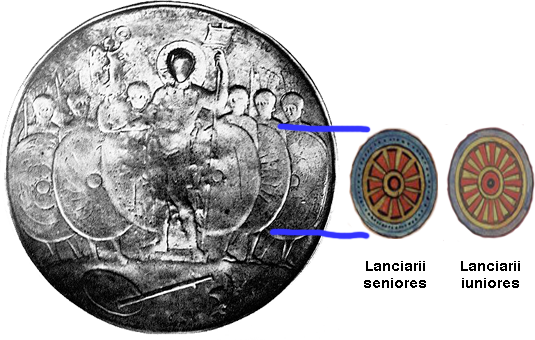
This page created 29 March 2014, and last modified: 3 October 2015 (further Maier reference numbers added)

In the eastern half of the empire, the most senior unit of legiones palatinae is the Lanciarii seniores, which is listed (9.17 in Ingo Maier's numbering scheme) as the first infantry unit under the command of the first Master of the Soldiers in the Imperial Presence, i.e the Magister Militum Praesentalis I. Its shield pattern (7#2) as shown in various manuscripts, under the matching label (7.b) Lanciarii seniores (Lancearii seniores in B), is as below:

The pattern shows a broad dotted blue double rim (the outside of which is instead purple in the Froben edition, B, and in "red" (i.e. faded purple) in the second Munich set, W, where the inner rim is cream instead of blue) with a yellow inner band; the dots (which are absent in P, M) may be an attempt to represent embossing. The shield boss is red, and encircled by a yellow band; yellow spokes radiate out to the yellow band inwards of the rim; the sectors between the spokes are red, there being 12 of these (10 in B). The shield patten is thus very similar to that of the Lanciarii iuniores (12.21), under the command of the second Master of the Soldiers in the Imperial Presence.
"The" Lanciarii, or alternatively, the Lancearii, with an "e", originated in the Tetrarchy, where they formed the nucleus of the Imperial reserve. In this period, they incorporated some mounted elements, as attested by inscriptional evidence (AE 1981, 777) where Aurelius Gaius' gravestone describes him (in Greek) as an "ippeus lankiaris". No evidence suggests that any of the units named Lanciarii in the Notitia included cavalry at the date of the document's composition (contrarily, only an argument from silence weighs against it...).
There exist a number of other legionary units in the Notitia styled lanciarii in addition to the above two:
Lanciarii Stobenses (18.22), a comitatenses unit under the Magister Militum per Thracias;Most of these units seem to have originated from standard legionary units rather than Imperial guards. "The" Lanciarii kept their elite status throughout the 4th century, fighting on at the disastrous battle of Adrianople, for example, until all was lost. In this connection, the so-called Missorium of Valentinian, a large silver plate showing either Valentinian I or II plus various guards/soldiers, and thus dating to just a few decades before the Notitia, is very instructive. As shown below, two of the shields, although worn, would appear to be very similar, or (given the wear) even identical, to that of the Lanciarii seniores and iuniores as shown in the Notitia (allowing for the fact that all the shields in the Notitia are shown as being circular, of course). The middle shield of those on the right of the dish, with its numerous spokes, would appear to be closest to the Lanciarii iuniores, while the inner shield of those on the left (and thus closest to the emperor's right hand), with its broad dotted rim, would appear to be closest to that of the Lanciarii seniores.
Lanciarii iuniores (21.22), a comitatenses unit under the Magister Militum per Illyricum;
Lanciarii Augustenses (21.20), another comitatenses unit under the Magister Militum per Illyricum;
Lanciarii Sabarienses (98/9.28), a palatine unit in the Magister Equitum's Gallic command;
Lanciarii Gallicani Honoriani (98/9.113; also called the Lanciarii Honoriani Gallicani), a comitatenses unit in the Magister Equitum's Gallic command;
Lanciarii Lauriacenses (98/9.133), a pseudocomitatenses unit under the Comes Illyricum; and
Lanciarii Comaginenses (98/9.134), another pseudocomitatenses unit under the Comes Illyricum.

"The" Lanciarii were often brigaded with the Mat(t)iarii (see e.g. Ammianus, 21.13.16; 31.13.8, and also a fragment (FGH IV,6) of Eutychianus of Cappadocia, cited by the 6th century Byzantine chronicler Malalas, describing Julian's Persian expedition). At what point the Lanciarii were divided between seniores and iuniores is unknown, but it may have been in the early 350s: E.A. Mehamadiev has connected the introduction of iuniores-seniores to the problem of replacing the casualties inflicted in the heavy fighting between Magnentius and Constantius II; see here (in Russian); it is interesting to note that in the Notitia it is the Matiarii iuniores (9.22) that is in the same command as the Lanciarii seniores, while the Matiarii seniores (12.16) is in the same command as the Lanciarii iuniores, and that neither pairing corresponds to two adjacently-ranked units. I would suggest that this implies that the two iuniores units had been relatively recently swapped between the two commands when the Notitia was first compiled.

Return to the Notitia alphabetical unit list page.
Return to my Notitia index page.